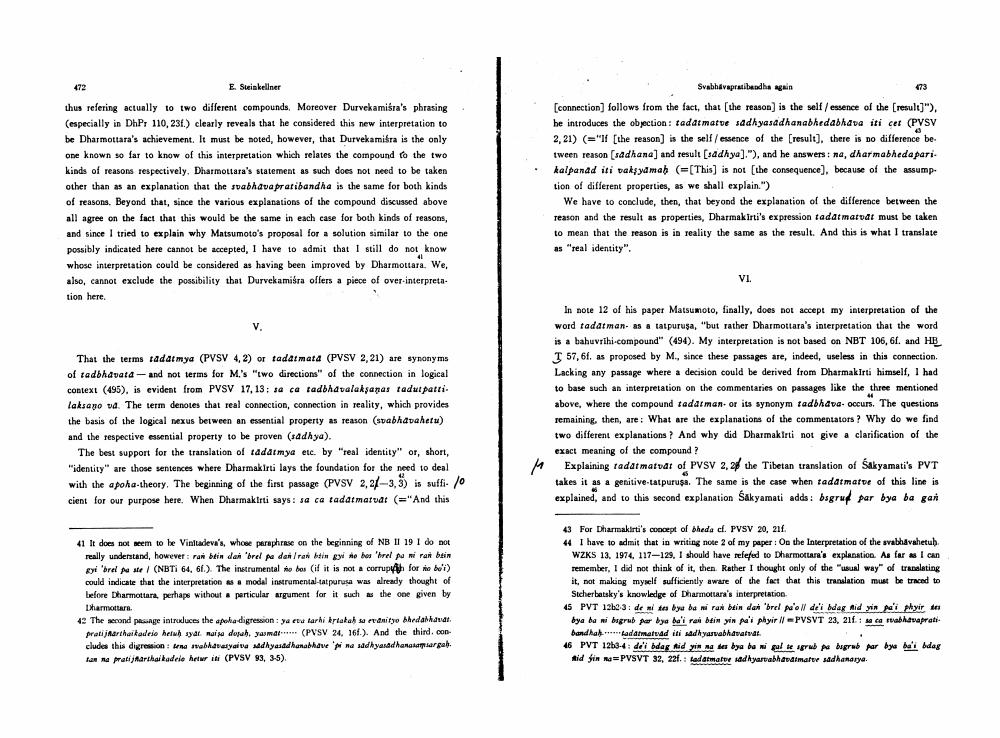Book Title: Svabhavarat Bandha Again Author(s): Ernat Steinkellner Publisher: Ernat Steinkellner View full book textPage 9
________________ 472 E. Steinkellner 73 thus refering actually to two different compounds. Moreover Durvekamiśra's phrasing (especially in DhP: 110,238.) clearly reveals that he considered this new interpretation to be Dharmottara's achievement. It must be noted, however, that Durvekamisra is the only one known so far to know of this interpretation which relates the compound to the two kinds of reasons respectively, Dharmollara's statement as such does not need to be taken other than as an explanation that the spabhava pratibandha is the same for both kinds of reasons. Beyond that, since the various explanations of the compound discussed above all agree on the fact that this would be the same in each case for both kinds of reasons, and since I tried to explain why Matsumoto's proposal for a solution similar to the one possibly indicated here cannot be accepted, I have to admit that I still do not know whose interpretation could be considered as having been improved by Dharmottara. We, also, cannot exclude the possibility that Durvekamisra offers a piece of over interpreta. tion here. Svabhavaraibandha again [connection) follows from the fact that the reason) is the self / essence of the resultJ"), he introduces the objection: tadatmatne sadhyasadhanabhedabhava iti cet (PVSV 2,21) (="If [the reason is the self essence of the result). there is no difference be. tween reason (sadhana] and result [sadhya]"), and he answers: na, dharmabheda pari. kalpanad iti vaksydmah (=[This) is not the consequence), because of the assump. tion of different properties, as we shall explain.") We have to conclude, then, that beyond the explanation of the difference between the Teason and the result as properties, Dharmakirti's expression tadatmatvat must be taken to mean that the reason is in reality the same as the result. And this is what I translate as "real identity" VI. That the terms tadatmya (PVSV 4.2) or tadatmata (PVSV 2,21) are synonyms of tadbhavata - and not terms for M.'s "two directions of the connection in logical context (495), is evident from PVSV 17, 13: sa ca tadbhavalaksanas tadut patti laksayo vd. The term denotes that real connection, connection in reality, which provides the basis of the logical nexus between an essential property as reason (svabhavahetu) and the respective essential property to be proven (sadhya). The best support for the translation of tadatmya etc. by "real identity" or, short, identity" are those sentences where Dharmakirti lays the foundation for the need to deal with the apo ha theory. The beginning of the first passage (PVSV 2.2/-3.3) is suffi. / cient for our purpose here. When Dharmakirti says: sa ca tadatmarval ("And this In note 12 of his paper Matsumoto, finally, does not accept my interpretation of the word tadarman as a tatpurusa, "but rather Dharmottara's interpretation that the word is a bahuvrihi-compound" (494). My interpretation is not based on NBT 106, 61. and HE. T 57, 61. as proposed by M., since these passages are, indeed, useless in this connection. Lacking any passage where a decision could be derived from Dharmak Irti himself, I had to base such an interpretation on the commentaries on passages like the three mentioned above, where the compound tada man or its synonym tadbhava. occurs. The questions remaining, then, are: What are the explanations of the commentators? Why do we find two different explanations And why did Dharmakirti not give a clarification of the exact meaning of the compound? Explaining radaimatvat of PVSV 2.2 the Tibetan translation of Sakyamati's PVT takes it as a genitive-latpurus. The same is the case when tadatmatve of this line is explained, and to this second explanation Sakyamati adds: bsgrup par bya ba gan 41 It does not seem to be Vinitadeva's, whose paraphrase on the beginning of NB II 19 I do not really understand, however : ran bin dan 'brel pe dan Iran din eyi de hos 'hrel Murant bin gyi 'brel Auste (NBTI 64, 61.). The instrumental mobos (if it is not a corrupath for me boi) could indicate that the interpretation as a modal instrumental at purusa was already thought of belore Dharmottare, perhaps without particular argument for it such as the one given by Larmottare. 42 The second page introduces the apoka digression: ya ebu tarhi krtelah seranitgo bheda kaudt. pretij Marthaikadele helw sya misa dosah. yama..... (PVSV 24, 361.). And the third concludea this digression Irna rabhavasyai na Mdhyasadhanabhawe 'n addhyaradhanalaisargah fax nafrati Marthaikadele hatur iti (PVSV 93, 3-5). 43 For Dharmakirti's concept of bheda c. PVSV 20, 211. 44 I have to admit that in writing note 2 of my paper : On the Interpretation of the sabhavahetub. WZKS 13. 1974. 117-129. I should have refefed to Dharmottara's explanation. As far as I can remember, I did not think of it, then Rather I thought only of the "wal way of translating it, not making myself sufficiently aware of the fact that this translation must be traced to Sicherbatsky's knowledge of Dharmotara's interpretation 45 PVT 1262 3: de sites byu ba ni raxi brin dar 'brel pa'oll de'i bdag Mid yin pa'i byir te bya ba ni bsgrub per bya ba'i rak bin yin pa'i phyir // PVSVT 23, 211: sa ca trabhasaprat bandhak...adatmatudd iti sadhyaswabhavalvde. 46 PVT 1213-4: de'i bdag nid yin na de bya ba ni gul te igrul A begreb par by he's bdag Kid frin na=PVSVT 32, 22f.: adatmalde adhyavabhaudematee sadhanaya.Page Navigation
1 ... 7 8 9 10 11
